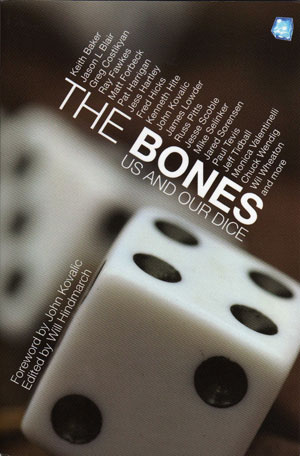God Plays Dice
The Bones: Us and our Dice, edited by Will Hindmarch
Do you remember your first set of polyhedral dice? Mine came in the old mid-1980s Dungeons & Dragons boxed set. They were a ridiculous baby-blue color and were almost ludicrously ugly. I couldn’t keep them with the boxed set, so I put them in a plastic baggie and stored them in a dresser drawer for a few decades.
A couple years ago, I decided to dig my original dice out — it turned out that I’d actually lost two of the six dice at some point. The fact that I’d managed to lose two of my original polyhedrals sent me on a dice-collecting binge for about a month. I still can’t bring myself to keep my original dice with my newer ones — I still hold out a vague hope that I’ll find the two lost ones someday, and I’ll be able to return the originals to my dice bag in triumph.
Please keep in mind, this is all coming from a guy who never gets a chance to play any roleplaying games. But I’m still obsessed with my dice.
And that’s what this book is about: dice. The history of dice, and our relationship with dice.
We start off with a few history lessons from Kenneth Hite and Irving Finkel (and a cartoon history from “Dork Tower” cartoonist John Kovalic), all about the very first dice — known as astrogaloi, the anklebones of a sheep, which had four sides that could be labeled and thrown, either as gambling implements, toys, or prophetic devices. There are other essays about randomness in games — and about randomness in computer games — as well as an interview with the inventor of the magnificent Dice-o-Matic.
After that come a number of essays, remembrances, funny stories, and entertaining ruminations on dice, games, and the ways they impact our lives. We get work from Wil Wheaton, Matt Forbeck, Jesse Scoble, Paul Tevis, Jeff Tidball, Monica Valentinelli, Ray Fawkes, Keith Baker, and many, many more.
Verdict: Thumbs up. I’m really a bit amazed how much fun this book was.
The historical articles at the beginning, outlining the development of dice and gaming from ancient times to today, were genuinely eye-opening, and the analysis by gaming guru Greg Costikyan on randomness-vs.-skill in games was similarly fascinating. The interview with the guy who invented a Lego machine designed to roll over a million dice every day, just to keep players in play-by-email games satisfied that their digital rolls were actually random, was both informative and funny — there’s little statistical difference between computer-generated random numbers and the rolls of six-sided dice, but gamers are more accepting of the randomness of dice.
The shorter essays filling the rest of the book are great, too. Some of them are fun because they’re slightly alien to me — see, a lot of them discuss the rituals gamers use to keep their dice lucky, or to punish them for not being lucky. Praising dice for good rolls, scolding them for bad ones, destroying them for consistent bad rolls. I’m very big on accepting the randomness of the dice rolls — unless the dice are designed to give crooked rolls, which few polyhedral dice are, some rolls will be good, some rolls will be bad, a lot of them will be fairly middling. But it’s interesting to read about all the dice rituals out there.
A lot of the other essays are great, too. We read about a wedding themed around dice, a story about actress Daryl Hannah, a tribute to six-sided dice, a tale about a set of homemade metal dice, and essays on dice and divination, dice as weapons, lost (and found) dice, the scarcity of modern polyhedral dice in third-world nations, and much, much more.
If you love games, if you love roleplaying, and if you find yourself sometimes obsessing over new dice, old dice, and the long-vanished 12-sider from your first RPG, you should go pick this one up.
Comments off

